Those who want to discover nature of Bohol will surely love the lush greenery and wildlife of the island. Writing about responsible tourism in Bohol, I focused on wildlife preservation and ethical choices you can take during your vacations. Bohol Island is a perfect place to admire the nature of central Visayas region. Great location makes it one of the most touristic places in the Philippines. After visiting stunning lagoons of Coron and checking alternatives for responsible traveler there, I came to see what ecotourism has to offer on Bohol.
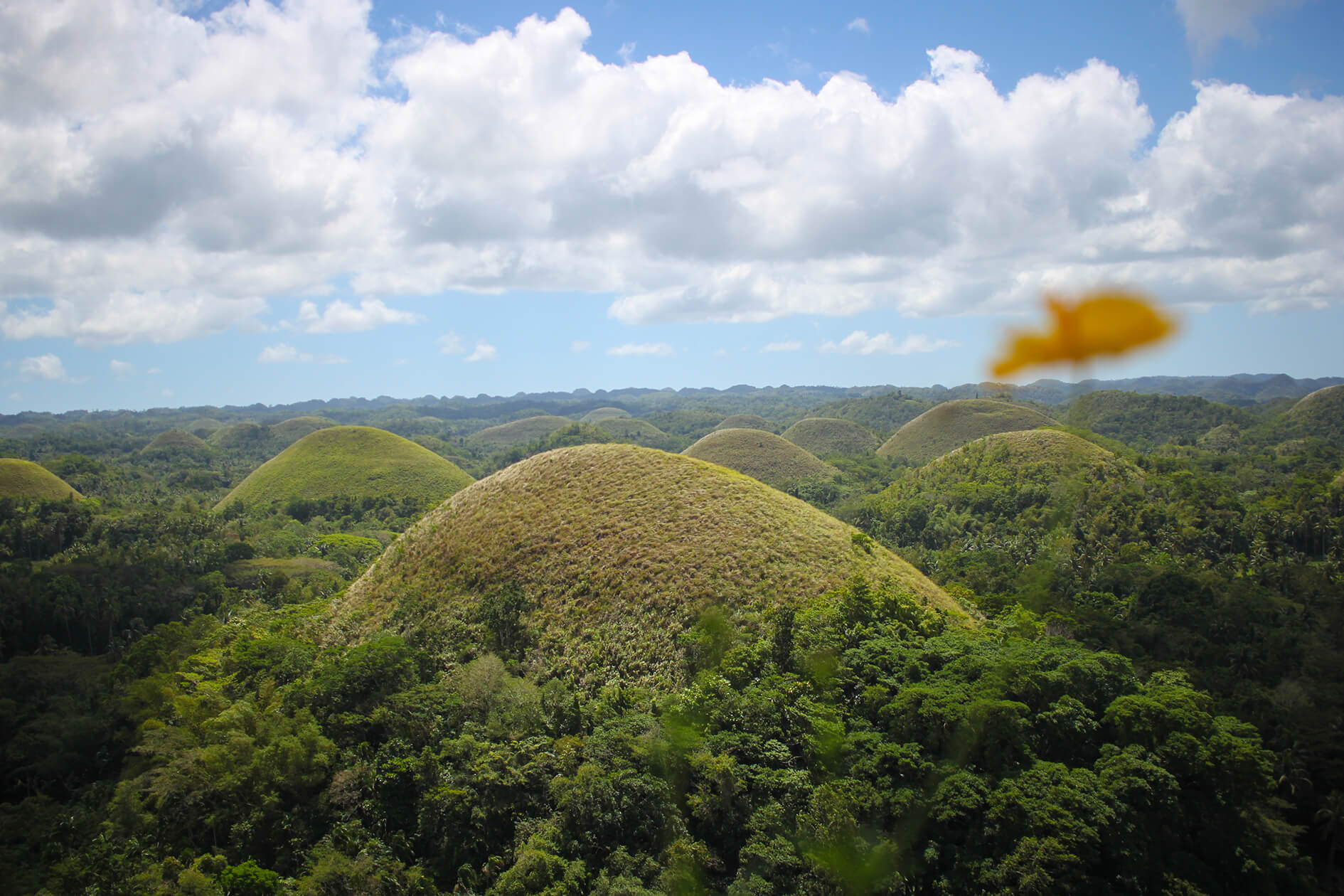
Nature of Bohol
Amidst the rice fields and fishing villages, you’ll find surprising things: unnatural-looking rounded hills as far as the eye can see, magical fireflies, lush green river, a goggle-eyed primate, and dazzling white-sand beaches on the next island across the bridge. Nature of Bohol is stunning and worth admiring for everyone. I prepared overview on few places I visited to check out the wildlife in Bohol. I want to encourage you to choose the activities wisely and get along with responsible tourism in Bohol.
Tarsier Sanctuary in Corella
Tarsiers are unique mammals, currently endangered. They are famous for huge eyes in compare with the rest of the body. In fact, their eyes are bigger than their brain as these animals are nocturnal – hunting at night.
Leading a mostly hidden life, a male tarsier needs at least 6 hectares of space and a female tarsier needs at least 2 hectares. If other tarsiers come into their territory, they will fight for it, and it can often lead to the death of the other. Moreover, tarsiers are very shy and easily getting stressed. With stress their chance of reproduction is very little. They are very hard to spot and visiting the sanctuary is questionable from the ethical point of view.
There are two places where you can see tarsiers in Bohol. One of them, more commercial is definitely not ethical. Tarsier Conservation Center in Lobok is basically a ZOO where tarsiers are in captivity and poor conditions. Small viewing area for tourists, roofs over tashiers and the walls around the conservation area, which you may not notice at the first glimpse.
Second one, in Corella is a sanctuary trying to preserve tarsiers from extinction. Rest assured, the net enclosure is only where they keep the tarsiers during feeding, breeding and display. It’s actually a free environment, and it’s only enclosed to keep possible predators (cats, etc.). Besides, the tarsiers can jump out of it whenever they want to. In here, you are also allowed to take pictures without flash but only quietly so as not to disturb the tarsiers who are asleep.
The Tarsier Trail, on the other hand, is a pathway that goes through a 134-hectare area of wilderness — you can hike through it with a guide in order to try and catch a glimpse of a Philippine tarsier in the wild (while also acquainting yourself with the local flora and fauna).
There are only few of them on a huge territory, so each one of them has enough space to hunt at night. It’s a silence zone as tarsiers are easly getting scared. When too much stressed they may even suicide!
I loved to see tarsiers, how cute and tiny they are. However, I was feeling disturbed by the mass tourism. Crowds from different nationalities talking loud, even though they know it’s a silence zone. They come 1 m near tashier to say loudly WOWWWWWWW! People would come up close to make the best picture possible, even though they were informed that they should keep distance. There is a guard standing all day near each tarsier to protect it… from people. He or she would keep reminding to stay away and keep quiet every minute. Seriously humans? Who’s brain is bigger? Summing up, I am not sure visiting tarsiers is a good idea. I left with my thoughts saying me that it wasn’t and something is not right here. Maybe we should just leave them in peace?
Entrance fee to Tarsiers sanctuary in Corella is 60 php.

Tashiers sanctuary in Corella, Bohol.
Fireflies watching
One of the things you can do in Bohol is watching the fireflies glowing in the dark. No matter if it’s Christmas time or not, you will see flashing Christmas trees out there. It’s a spectacle of tiny insects attracting the other sex with a sparkling light. They gather near blooming mangrove trees in a place with no pollution. Therefore, less and less of fireflies can be seen. Even in my village, in Poland, we used to have fireflies when I was a kid. Nowadays, with developed agriculture, pesticides killed them all, together with butterflies, bees and many other insects as well as several species of birds which are no longer there. How sad.
To see the fireflies in Bohol, you need to come to the Abatan River where the cruise starts. Abatan is also home to endangered plants and animal species including the mangrove Camptostemon philippinese (locally known as Gapas-gapas) which is globally endangered and the rarest mangrove species in the Philippines. Responsible travel isn’t just about the environment; it’s also about improving the lives of local people. The tour was created to generate income for the farmers and fisherfolk who live along the river and to encourage community participation in the conservation, preservation and management of the environment and cultural heritage of the area.
There will be kayaks to rent and few boats depending on the number of visitors but be sure that you will have one tour at 18 30, 19 30 and 20 30. The cruise lasts for 30 or 40 min and you will get to see many Christmas trees with moving decorations. Such a beauty! Another possibility to see fireflies is on the Lobok river, so if you are staying in this part of Bohol, check this option out. As I was staying in Tagbilaran it was easy to come to Abatan River using public transport of Bohol. The bus was heading towards Tubigon and dropped me exactly next to the entrance to Abatan River Village Center. The bus ticket costed 50 pesos and the fireflies tour 500 pesos.
Butterflies Sanctuaries
There are two butterflies sanctuaries in Bohol, in Bilar town, and a smaller enclosure is in Sagbayan. There are more or less 300 butterfly species native to the province and the sanctuaries are aiming to conserve and raise the butterfly population in the island. Lovely to visit the little garden full of flowers and butterflies roaming around. The ticket costs 50 pesos.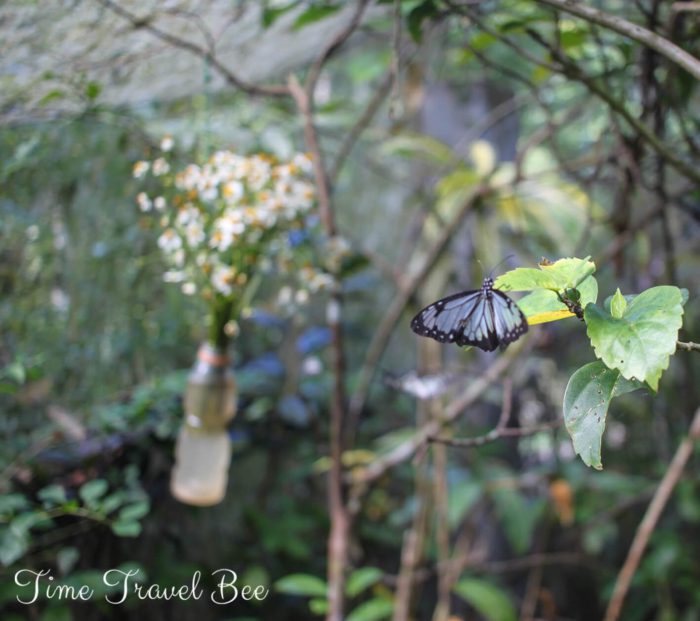
Lobok river
There is no visit in Bohol without visiting Lobok. The nature of the valley is so lush green and exotic. It’s a pity that it became so touristic where hundreds of visitors come every single day for boat cruise on the river. When you arrive to Lobok, you are given the priority number, which puts you in the queue for the floating restaurant tour. After that, you proceed to a huge square with all the souvenirs shops and seats where the queue is moving. The cruise costs 500 pesos and includes 1 hour ride along the river with lunch on the boat.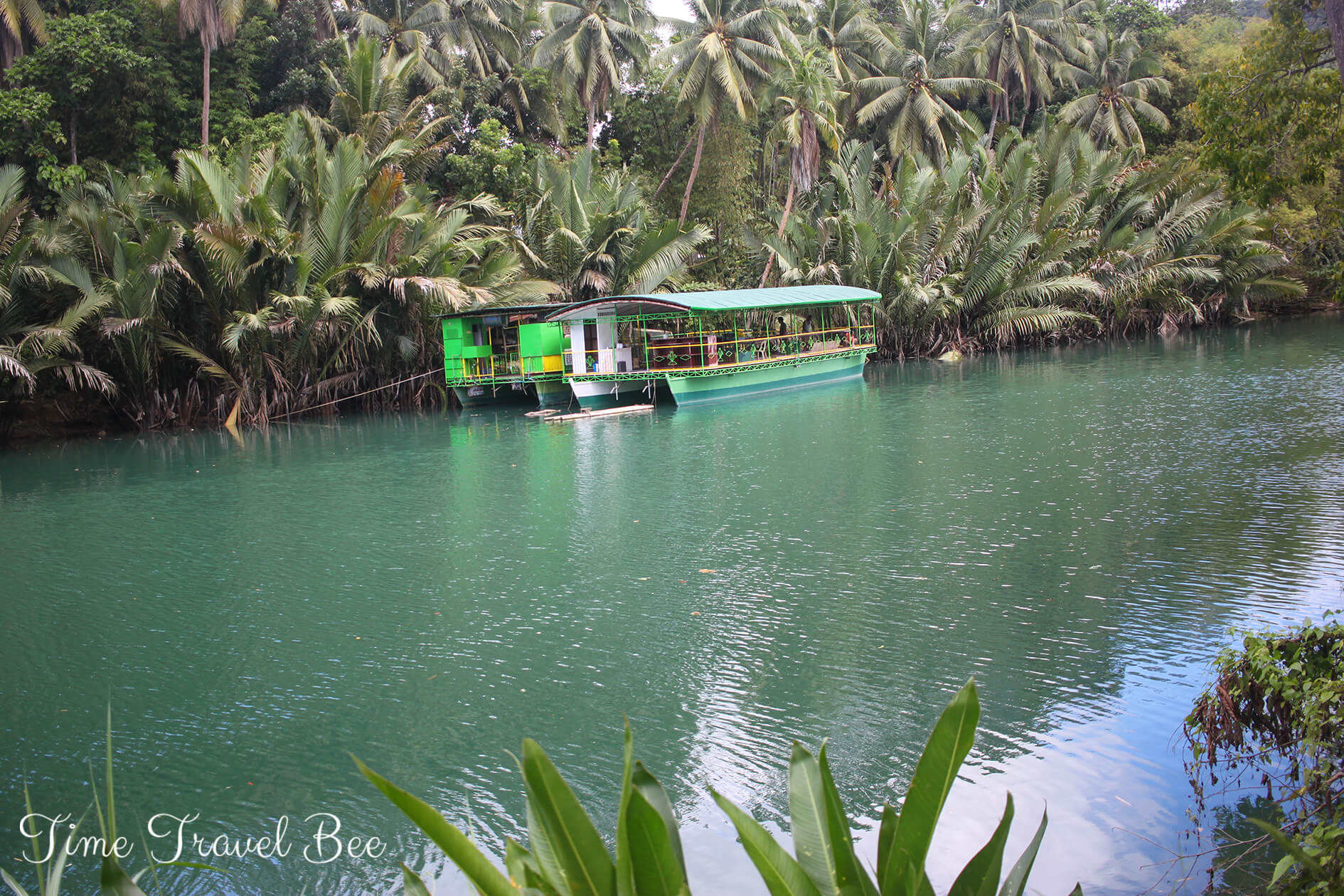
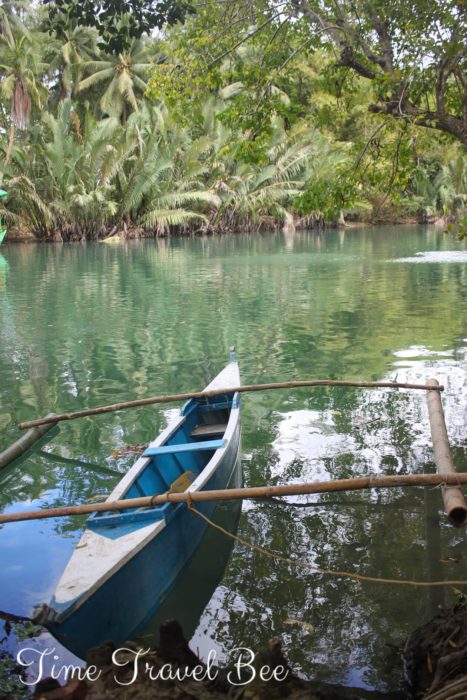 As I try to stay away from mass tourism whenever possible, I was looking for another option to see the Lobok river closely. I found water bikes, just behind the floating restaurant. The price is 300 pesos for max 1 hour. It’s too much, I thought, as with the bicycle you cannot go very far in 1 hour, which means you will just make pictures on the bicycle and not even leave the village to see the lush greenery of the river. I continued walking to look for possible alternatives. I went along the river to the resort which rents padel boards SUP. They are a bit out of the village so the views along the river are already beautiful and remote. However, 800 pesos for 1 hour rent was a bit too much for me.
As I try to stay away from mass tourism whenever possible, I was looking for another option to see the Lobok river closely. I found water bikes, just behind the floating restaurant. The price is 300 pesos for max 1 hour. It’s too much, I thought, as with the bicycle you cannot go very far in 1 hour, which means you will just make pictures on the bicycle and not even leave the village to see the lush greenery of the river. I continued walking to look for possible alternatives. I went along the river to the resort which rents padel boards SUP. They are a bit out of the village so the views along the river are already beautiful and remote. However, 800 pesos for 1 hour rent was a bit too much for me.
I went back to the village and tried to walk from the other side of the river. It was a small village street with locals waving and kids saying “hi” every minute. Everyone looked so happy to see tourists in this corner of Lobok. I saw a man selling sweets and basic products in a little wooden shop. I spotted a kayak behind and asked if it’s his property and if I can use it. He agreed in a second!
Just the river and me! Stunning colors around, green river and the cruise boats passing with people taking photos of me. It felt funny, that I became a tourist attraction for Chinese people. I went until I felt tired of paddling and came back. I gave a tip of 100 pesos to the kayak owner and he seemed to be surprised. Everyone happy.
Snorkeling in Bohol
Bohol Island is famous for snorkeling and there are many spots to admire the marine life. The most popular one in on Panglao Island, near Alone Beach. There are also Marine Sanctuaries along the coast, where you can enter paying little fee and enjoy the underwater world.
Hinagdanan Cave
Hinagdanan Cave was accidentally discovered when the owner of the area was clearing the decaying branches of the land and he found the hole. He threw a stone into the hole, then he heard a splash. Later, he built a ladder and as it was the way to get into the cave, people named it Hinagdanan, means “laddered”.
Hinagdanan is boasting several stalactites and stalagmite formations parallel to each other and a fresh water lagoon that is about 10 to 12 meters deep. The cave is about 100 metres long of beautiful rock formations. The lagoon in the cave has lovely greenish color due to the green limestone at the bottom of the pool. The entrance fee to Hinagdanan Cave is 25 pesos but if you want to swim in the lagoon it’s additional fee of 100 pesos.
Chocolate Hills
These weird shape hills stand in the central Bohol. When I was there they were covered in green grass, which turns brown (like a chocolate) during the dry season, hence the name. The geologists say that they are weathered formations of a marine limestone lying on top of an impenetrable clay base. Can you imagine all this place was sea and the chocolate hills grew up on corals? It sounds amazing!
Some people decide to skip these strange domes, because they are touristic. However, I think the shape and landscape is a bit out of this world and it’s worth to see them at least from the viewpoint. If you are more adventurous, you can rent a mountain bike and go up and down the steep slopes without crowd on your back. Getting to Chocolate may be tricky, if you meet the taxi drivers which want to earn on you. But there is a public transport very easy and cheap.
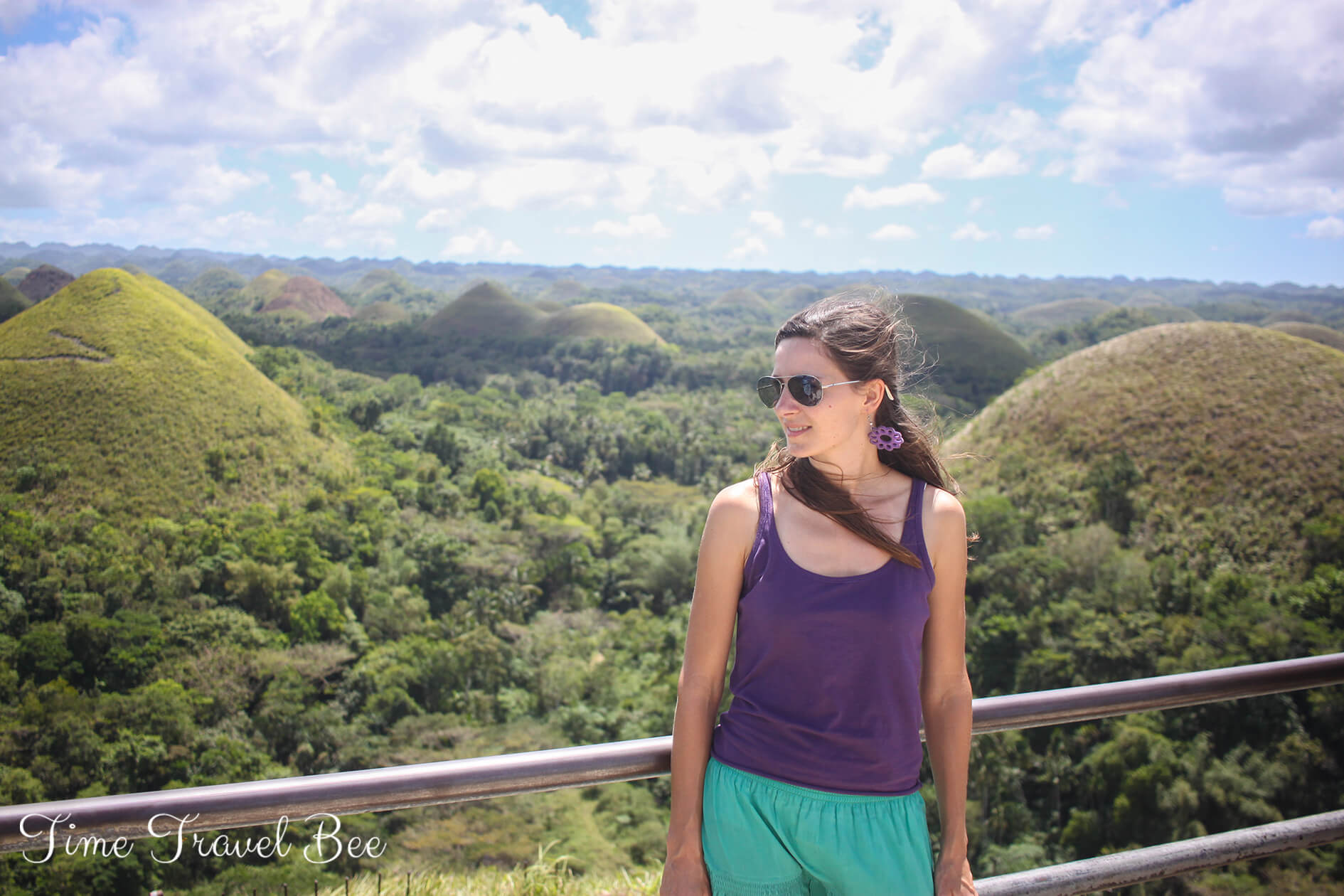
Responsible tourism in Bohol
Bohol is a top biodiversity area. Apart from Bohol Environmental Management Office, local communities are encouraged to take action, which results in higher awareness in protecting the nature of Bohol. Responsible tourism in Bohol tries to protect the wetlands, coral reef, mangrove forest and wildlife species of the island.
Be aware of choosing the places to visit responsibly. Before visiting an animal sanctuary read about the place and check if they really care about the animals protection or just about money. Not all sanctuaries treat animals rights and that is really confusing for tourists. Think twice before you go to see tarsiers or make selfie with the python in the Python Sanctuary. Sometimes it’s better to skip it and leave the animals in peace.
Flying produce the biggest amount of carbon footprint from all means of transporation. In the Phillipines, it’s really hard to avoid planes. However, Bohol is one of those islands which are well connected with by ferries with the nearst Islands – Siquijor, which was my favorite in the country and 3 hours ferry from Cebu City, with the biggest international airport in the area.
Our travel choices make a difference!
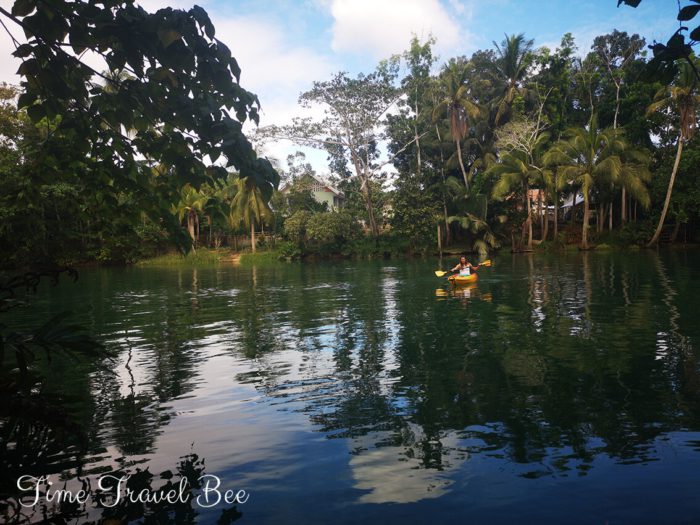
The Bee is a nature lover and tea addict. Loves the idea of slow life and responsible traveling, constantly trying to improve to bee more eco-friendly. Appreciates old cultures and traditions, loves to immerse with locals, listen to ethnic music as well as taste regional food and drinks. Her favorite spots while traveling are family houses and street markets.

I really appreciate your care for the nature and the environment also when you are traveling! There should be more travelers like you, me also! So thanks for reminding us of how it is important to travel green! We were just recently looking to go to Bohol but if we had stumbled upon your post earlier I am sure we would have gone there! The fireflies sounds like a dream, but I think we would skip the Tersier because of the same reason you mention. And like the way you travel, out of the tourist mass to find your own way and you did…a kayak! Lol, I thought you would go with the SUP😊
Yeah I would love to go with the SUP, but it was quite pricy for me. As I travel long term need to be carefull about my budget. I need to try those paddles one day, though.
Wow how enriching it must be to be able to travel to places like this. I hope someday to be able to go here as well.
I can’t believe i’ve never been to the Philippines yet ugh!!! Soonnnnnn!!! Bohol is gorgeous.
Bohol looks amazing, I love that there are so many places where you can enjoy the nature and the wildlife, without too much human interaction. I would love to travel to there, responsibly of course. We need to protect the nature no matter if we are home or we travel.
I have always wanted to visit Bohol and especially the Chocolate Hills in the Philippines. I have heard about Tarsiers but did not know that they require so many hectares between them. I am all for their protection and against mass tourism. Great words of wisdom from you about researching all animal sanctuaries, zoos etc before you visit, this is something that I am starting to do these days.
That’s right Jane, sometimes I come to the place and I am shocked how people use animals to make profit. That really makes me and I guess most of the people research about the places before paying to support businesses like that.
Wow! Bohol looks stunning! It looks like the perfect place to visit to appreciate nature.
It’s amazing! Thanks for visiting Christa
I’ve always wanted to go to Bohol and experience what this amazing place has to offer. Especially the world known chocolate hills that I’ve wanted to see.
Indeed, Chocolate Hills are unique and look unreal!
I like the fact that you highlighted how tourism should be practised responsibly. I was disgusted with how some tourists react in the Tarsier Sanctuary – how disturbing it is for the animals. It was also nice to read how you got to borrow the kayak from a generous man and got to see the river that way. Thumbs up for this post and your bit to highlight responsible tourism.
Thank you so much Adele for your supportive words!
I love your impressions of Bohol, it all looks like a pure natural paradise! Very sad to hear about the tarsiers and how people behave there. I also made similar experiences during my trips. There are people without any respect for anything. Everything just for the best photo and without empathy for others, that is truly a shame! Lobok looks and sounds also very interesting. Pity that mass tourism also reached that place. Very interesting article and I agree with you. Yes, Tourism helps such regions and brings money, but responsibility for the local animals is surely the most important.
Thank you so much for your feedback Hendrik!
Never been to this place but that place looks very vibrant to relax and unwind. Looks like you had a great time there!
wow! such a beautiful location! It so makes me crave for warmth and travels. I miss green badly!
Oh my goodness I just want to climb into your pictures and never leave! Thank you so much for sharing such a gorgeous trip with all of us!
Wow! Loving this introduction to Bohol which I’d not come across before. The lush greenery, and those magnicent bosom-like chocolate hills are just breathtaking! We also love to travel for wildlife, so the Tarsier Sanctuary would be on our list, plus activities to see the rest of the wildlife on offer.
Bohol looks indeed a little unnatural-looking with those rounded hills, but absolutely stunning! Nature is so pristine on these islands and so unique. There seems to be a lot to see and do there. I’ve never seen a tarsier in real life. Not even in a zoo. It’s interesting to read they need so much territory. Hope to visit Bohol Island someday.
That is a ton of fireflies in such a short time! I love all of the nature and animals that you highlight for Bohol. Certainly visiting butterflies is a very different experience than seeing those adorable little Tarsiers, either some people need a little extra education to be quiet and not startle the wild animals. It sounds like the area is taking good steps toward responsible environmental management for residents and tourists alike.
I think butterfly sanctuaries are so beautiful. There’s something so peaceful about them.
The rounded green hills of Bohol won me over for this place. I have never seen fireflies in real and therefore visiting fireflies sanctuary would be unique thing to here. It is great local authorities of Bohol takes care of wildlife.
The font on this blog are pretty cute! I love visiting Visayas and I wish our next travels will be in this place!
Thanks Mary!
I would love to watch fireflies here!
Wow, you really make it enticing to visit Bohol. I wish that more travelers would think the way like you.
Thank you so much!
I am so glad you wrote this post. When I visited Bohol, I was very cautious of travelling responsibly. And, that’s why just like you, I chose to visit the Tarsier Sanctuary in Corella. It was such a great experience watching those beautiful creatures. I loved my time at Chocolate hills, Lombok River and doing the fireflies tour.
OMG this is a perfect guide! We are going to Bohol this weekend and still searching what activities and places to visit aside from spending time in the beach. I would love to visit the tarsiers sanctuary and watch those butterflies!
Hope you will find it useful on your trip! Enjoy Bohol!
This is a very thoughtful post and as travelers we should all think of traveling responsibly. Every little contribution matters. Yes, we must find out about the places before visiting them, especially if they are related to animal management. Your reasons were very convincing.
I had never heard of a place called Bohol. It was good to know about it.
Bohol is one of the most touristic islands in the Philippines, if you ever go to this country I am sure you hear about it, and want to visit 😉
This is a lovely place to experience unique animals and nature. Caves and snorkeling are two of my favorites. And the Tarsier Trail sounds perfect to look for these elusive creatures. They sure look so so cute. Good that you shared about which one of the viewings is more ethical
Bohol is actually one of my favorite places here in the Philippines. In fact, we’ll be there next week but just in Panglao. I love how they kept the place sustainable despite the influx of tourists. Hope they get to keep Bohol that way in the next 100 years or so.
As I always say, Philippines is blessed abundantly by Mother Nature. Bohol is no exception. The natural beauty of your country needs to be taken care of. So, I’m happy to read your take on responsible tourism.
It’s sad that someone needs to guard the Tarsiers from tourists. It’s really hard for the government to find the mid-point between protecting the animals and making some revenue from tourism.
I do hope we humans grow some senses…
Bohol looks like an amazing place. The next time I visit the Philippines, Bohol must be on my list.
The more I read about Philippines, the more pictures I see, the more I want to visit this beautiful country, hopefully soon 🙂
Everything about Bobol sounds interesting to me, where nature stands still to be photographed.